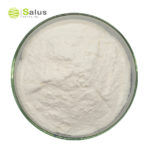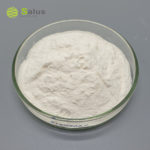
86-29-63699260 / +86-137-5995-3739

Sale@salusnutra.com


Product Name: Ascorbyl Glucoside
CAS Number: 129499-78-1
EINECS No: 253-874-2
Empirical Formula (Hill Notation): C12H18O11
Specification:99% By HPLC
Package:25Kg/Drum
Drum’s Size:36cm*36cm*52cm
Shelf Time:2 Years
At the risk of channeling overly complicated, high school chemistry class vibes, ascorbyl glucoside is a water-soluble form of vitamin C that’s combined with glucose, a sugar. In the world of vitamin C and its derivatives, l-ascorbic acid is the most potent, pure version (just like retinoic acid is when you’re talking about retinoids). “Once ascorbyl glucoside is absorbed into the skin, an enzyme called alpha-glucosidas breaks it down into l-ascorbic acid,” explains Nussbaum. This is why you then get all those awesome vitamin C effects such as skin-brightening and wrinkle-smoothing, but, in this case, because it’s undergone a conversion process, it’s much less likely to cause irritation. This also makes it much more stable; whereas l-ascorbic acid is notoriously unstable and easily rendered inactive by exposure to oxygen or light, ascorbyl glucoside is a lot more stable in heat, light exposure, and oxygen, says Solomon. And that’s exactly why it’s so often used in so many beauty products. (FYI, you may also see it listed on an ingredient label as Vitamin CG.) The bottom line: While ascorbyl glucoside is not as potent as the pure stuff, because it is so stable you can feel confident it’s working, and it’s also gentler on skin.
|
Item |
Standard |
|
Appearance |
White to cream powder |
|
pH |
2.3~2.4 |
|
Melting Point |
158℃~163℃ |
|
Optical rotation |
+186.0°~+188.0° |
|
Loss on drying |
≤1.0% |
|
Residue on ignition |
≤0.2% |
|
Free ascorbic acid |
≤0.1% |
|
Free glucose |
≤0.1% |
|
Heavy metals(pb) |
≤10ppm |
|
Arsenic(AS2O3) |
≤1ppm |
|
Assay |
≥98.0% |
|
purity |
≥99.5% |
|
Total bacteria (CFU/g) |
< 100 |
|
Yeast and mold (CFU/g) |
< 10 |
Your best bet for exact usage will vary based from product to product and its intended purpose, notes Solomon. As a general rule of thumb, you’ll want to use it at least once a day. The morning is a great time to do so, since all those antioxidant properties will act as a second layer of defense to back up your sunscreen: “Used under sunscreen it can help boost its UV protection,” she adds. Look for it in a serum, which will not only be concentrated with the ingredient to give you more bang for your buck, but will also be lightweight and easily layered under moisturizer and said sunscreen.
At the end of the day, all types of vitamin C are antioxidant powerhouses, though the benefits definitely don’t stop there.
Antioxidants tend to have a synergistic effect when combined, which is why this ingredient works so well when paired with other commonly used antioxidants such as vitamin E or ferulic acid.

Send Message +
© 2021 www.salusnutra.com All Rights Reserve